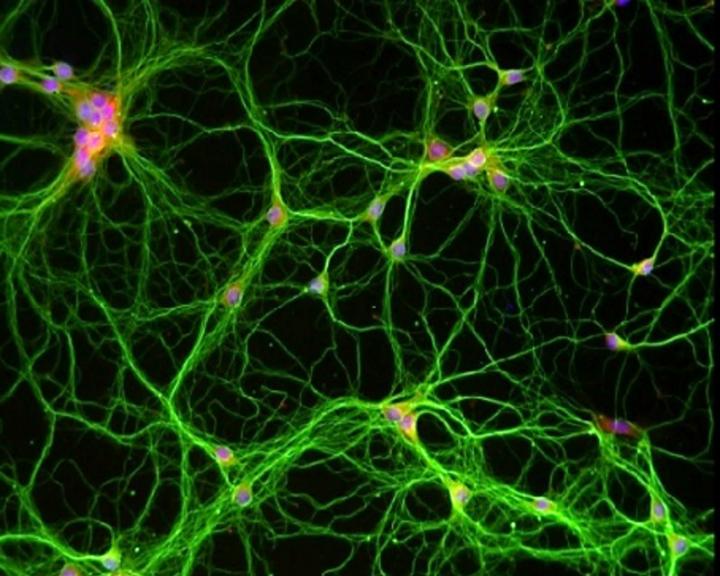![<i>In vitro</i> and <i>in vivo</i> experiments reveal that memory formation requires that an acetate-dependent metabolic enzyme, acetyl-CoA synthetase 2 (ACSS2), be near specific regions of DNA so that certain genes may be epigenetically regulated. In this image, primary neurons from the hippocampus isolated from a mouse embryo. Axons are green, nuclei are stained blue, and ACSS2 is red, so overlap is pink-purple. [Philipp Mews, Ph.D./Perelman School of Medicine, University of Pennsylvania]” /><br />
<span class=](https://genengnews.com/wp-content/uploads/2018/08/Jun1_2017_UPenn_MouseEmbryo2267811741-1.jpg) In vitro and in vivo experiments reveal that memory formation requires that an acetate-dependent metabolic enzyme, acetyl-CoA synthetase 2 (ACSS2), be near specific regions of DNA so that certain genes may be epigenetically regulated. In this image, primary neurons from the hippocampus isolated from a mouse embryo. Axons are green, nuclei are stained blue, and ACSS2 is red, so overlap is pink-purple. [Philipp Mews, Ph.D./Perelman School of Medicine, University of Pennsylvania]
In vitro and in vivo experiments reveal that memory formation requires that an acetate-dependent metabolic enzyme, acetyl-CoA synthetase 2 (ACSS2), be near specific regions of DNA so that certain genes may be epigenetically regulated. In this image, primary neurons from the hippocampus isolated from a mouse embryo. Axons are green, nuclei are stained blue, and ACSS2 is red, so overlap is pink-purple. [Philipp Mews, Ph.D./Perelman School of Medicine, University of Pennsylvania]
Memory formation depends on synaptic remodeling, which depends on the activation of certain genes, which depends on histone acetylation, which depends on the production of locally available acetate. In this chain of processes, some links are better understood than others. The last two links, in particular, need closer attention.
Helping to fill the gap in our knowledge of synapse formation, researchers from the Perelman School of Medicine at the University of Pennsylvania have discovered, in the mouse brain, that a key metabolic enzyme works directly within the nucleus of neurons to turn genes on or off when new memories are being established.
In short, the researchers have shown that the metabolic enzyme acetyl-CoA synthetase 2 (ACSS2) directly regulates histone acetylation in neurons and spatial memory in mammals. This finding, the researchers suggest, reveals that cellular metabolism, gene regulation, and neural plasticity are all connected.
Additional details appeared May 31 in Nature, in an article entitled “Acetyl-CoA Synthetase Regulates Histone Acetylation and Hippocampal Memory.” These details include descriptions of the regulation of histone acetylation and transcriptional dynamics during differentiation in vitro and in response to behavioral training in vivo. Ultimately, the article makes a case that a link exists between acetyl-CoA generation “on site” at chromatin for histone acetylation and the transcription of key neuronal genes.
“In a neuronal cell culture model, ACSS2 increases in the nuclei of differentiating neurons and localizes to upregulated neuronal genes near sites of elevated histone acetylation,” the article’s authors wrote. “A decrease in ACSS2 lowers nuclear acetyl-CoA levels, histone acetylation, and responsive expression of the cohort of neuronal genes.”
“In adult mice, attenuation of hippocampal ACSS2 expression impairs long-term spatial memory, a cognitive process that relies on histone acetylation. A decrease in ACSS2 in the hippocampus also leads to defective upregulation of memory-related neuronal genes that are pre-bound by ACSS2.”
This work was accomplished by a team of scientists led by Shelley L. Berger, Ph.D., the Daniel S. Och University Professor in the departments cell and developmental biology and biology and director of the Penn Epigenetics Program. She summarized the team’s findings as follows: “ACSS2 'fuels' a whole machinery of gene expression 'on site' in the nucleus of nerve cells to turn on key memory genes after learning. We found both direct gene-association of ACSS2 and a role for it in neurons to regulate learning and memory—two completely unanticipated novel discoveries.”
This study provides a new target for neuropsychiatric disorders, such as anxiety and depression, where neuro-epigenetic mechanisms are known to be key, added the Nature article’s first author Philipp Mews, Ph.D., a former graduate student in the Berger lab who is now a postdoctoral fellow at the Friedman Brain Institute of the Icahn School of Medicine at Mount Sinai in New York City. “We suspect,” Dr. Mews stated, “that ACSS2 might play a role in memory impairment in neurodegenerative disorders.”
Forming memories involves restructuring of the synapse, which relies on the coordinated expression of a group of memory genes. The addition of a chemical group, a process called acetylation, onto specific spots of the genome in neurons, opens up tightly wound DNA to make genes involved in memory formation available to be “read,” and eventually, for their encoded proteins to be made.
Epigenetic mechanisms in neurobiology—the addition or subtraction of the chemical groups that influence gene expression—are becoming better understood as important regulators of the many functions of different neurons. In the new study, the Penn team found that the enzyme ACSS2 binds to memory genes in neurons to directly regulate and fuel their acetylation, which is ultimately controlling spatial memory in mice.
In the future, Drs. Mews and Berger hope to apply this newfound memory path to prevent the “laying-down” of traumatic memories—or perhaps even erase them—in people who suffer from posttraumatic stress disorder, by blocking ACSS2 in the hippocampus, a brain region that processes long-term memory.







